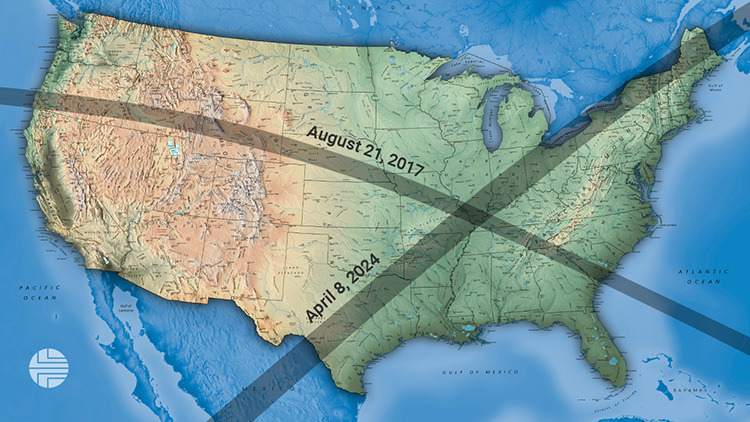Eclipse 2024: Keeping the Lights on When the Skies Go Dark

As millions of New Yorkers are treated to a view of a total solar eclipse, we at the NYISO will be monitoring its impacts and managing the power grid, which is incorporating more clean energy resources than ever.
On April 8, 2024, the moon will completely obscure the sun, turning day into night across the state for up to 3.5 minutes, between 3:15 p.m. and 3:30 p.m.
The upcoming solar eclipse is exceptional for both its broad path of totality across New York and the potentially large reduction to solar power generation over a short period of time, according to Mark Taylor, a technical specialist and meteorologist at the NYISO.
“During the 2017 eclipse, the sun became roughly 75% obscured and subsequently cut solar generation in New York by about 500 megawatts,” Taylor said. “Today, we have five times as much solar generation throughout the state, but the amount of cloud cover will ultimately determine how much generation is lost during the eclipse.”
Understanding how solar generation helps shave peak demand, experts began examining the eclipse’s potential effects on solar energy production months ago.
The NYISO’s solar forecasting tools anticipate how much solar energy production the system can expect throughout the day, and helps our planners and operators determine resource needs to meet expected demand. If unexpected circumstances arise and solar resources aren’t producing power as initially forecasted, the NYISO’s operations team must find a way to make up the difference.
Assuming clear skies on April 8, the NYISO expects solar energy production to be about 3,500 megawatts (MW) as the eclipse begins. In little more than an hour, that production will likely drop to as few as 300 MW before rising quickly again to about 2,000 MW and then declining quickly in the waning hours of the afternoon.
The actual solar power reduction caused by the eclipse will depend upon weather conditions throughout the event, especially the amount of cloud cover. This additional uncertainty underscores the need for flexible generation and storage resources to help maintain system reliability in the future.
The loss of nearly 3,000 MW of generation is significant, even when it can be anticipated, and requires additional resources to be available for the system to account for the loss. Since over 90% of statewide solar generation is provided by behind-the-meter (BTM) resources, there are additional challenges from a lack of real-time visibility. Nonetheless, grid operators must still make up for any lost production to reliably serve demand.
In addition to the solar energy production impacts introduced by the eclipse, changes in weather can also result in deviations between day-ahead forecasts and actual real-time conditions.
“Partial-sun days often carry increased forecast uncertainty,” Taylor said.

and the 2024 total solar eclipse, crossing from Mexico into Texas, and exiting over Canada.
Compared to the 2017 eclipse, where totality did not cut across New York and the potential statewide solar power reduction was far less, the April event will completely darken most of the state. The path of totality will cross most of Western New York, northern parts of Central New York, and the Adirondack region.
As solar capacity continues to expand, the connection between eclipse events and grid reliability reflects the state’s progress towards decarbonization. Grid planners and operators will need to account for these new challenges as we work to deliver the grid of the future.
